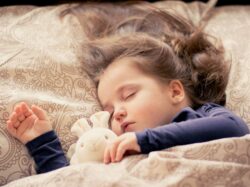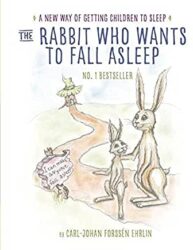Hypnotic Language : my selection of books to help your child fall asleep
Maybe I should have started the sleep theme with this article: books to help your child fall asleep. But I know that not all parents experience the same difficulties with their children’s sleep.
Some have children who sleep like babies (Ah ah! That expression!
People who say they sleep like babies usually don’t have one.
Leo J. Burke
On the other hand, others are not so lucky and worry because their children don’t get a good night’s sleep or because they don’t seem calm and serene while sleeping.
 Clearly, I’ve been in that second category for a long time. My daughter started to have nightmares and night terrors when she was 18 months old. She was a restless sleeper and often fell out of bed (far too often!). We went through sleepwalking phases as well. She was far below the recommended number of hours of sleep for a child. Beyond the fact that I was tired (when there is only one to two nights a month without worries), what worried me most was her own fatigue. I could also see that her sensitivity was more difficult to apprehend for her when she didn’t get enough sleep.
Clearly, I’ve been in that second category for a long time. My daughter started to have nightmares and night terrors when she was 18 months old. She was a restless sleeper and often fell out of bed (far too often!). We went through sleepwalking phases as well. She was far below the recommended number of hours of sleep for a child. Beyond the fact that I was tired (when there is only one to two nights a month without worries), what worried me most was her own fatigue. I could also see that her sensitivity was more difficult to apprehend for her when she didn’t get enough sleep.
She didn’t like to go to bed at night for fear of “missing something that would happen”, so she ended up hating the night. Bedtime had become a test of strength where I spent a lot of energy to stay calm. So my husband and I chose to invest time for a the long term and not necessarily to be efficient as quickly as possible. We took our time (we still do) to make her see what’s good in night and sleep. The long term goal is that she should not be apprehensive, when she will be an adult, about the evening, or about bedtime. On the contrary, we hope that she will see the night as an ally to regenerate herself. Today, I share with you some books that have helped us in our process.
The Rabbit Who Wants to Fall Asleep: A New Way of Getting Children to Sleep
by Illustrations : . 3+
Back cover
 Do you struggle with getting your child to fall asleep?
Do you struggle with getting your child to fall asleep?
Join parents all over the world who have embraced The Rabbit Who Wants to Fall Asleep as their new nightly routine.
When Roger can’t fall asleep, Mommy Rabbit takes him to see Uncle Yawn, who knows just what to do. Children will join Roger on his journey and be lulled to sleep alongside their new friend.
Why I love this book
It’s the first book of its kind I’ve ever bought; I was interested by the back cover. At that time, my daughter had night terrors and a lot of nightmares. She was nervous with the idea of going to bed. Something had to be changed so she could relax and fall asleep peacefully.
This book was the first step towards a more serene sleep. We read it dozens (if not hundereds) of times. At the end, I knew it by heart. It was very effective. Indeed, my daughter always fell asleep before the end of the story (usually after 3 to 4 pages). But as she grew up, it became a problem: she wanted to hear the whole story 😉 .
The Little Elephant Who Wants to Fall Asleep: A New Way of Getting Children to Sleep
by ; Illustrations : Sydney Hanson ; Publishers: Crown Books for Young Readers. 3+.
Back cover

Your child joins Ellen the Elephant on a journey through a magical forest that leads to sleep. Along the way, they meet different fantastical characters and have calming experiences that will help your child relax and slip into slumber quickly. The story works perfectly for either naptime or bedtime.
Carl-Johan Forssén Ehrlin’s simple story uses soothing language and new sleep techniques to reclaim bedtime. And this edition includes insightful tips and answers to frequently asked questions to help guide families to an even more satisfying nighttime routine.
Why I love this book
This second book came at just the right time when my daughter was tired of the rabbit. The book is similar to the first one, with a new character, feminine this time (my daughter likes it very much). In fact, I prefer it to the first one because I find the story more accomplished and Helene, the little elephant, very endearing. And finally, the illustrations are magnificent.
There are two other books that helped us a lot (and still help us) which exist only in a french version for now
- Le marchand de sable va passer by Valérie Roumanoff ; Illustrations : Katherine Roumanoff ; Eds. First
- Les histoires magiques du soir by Valérie Roumanoff ; Illustrations : Carole Ibrahima ; Eds. First
This second book exists in German though.
Interview of Valérie Roumanoff
titoudou – Hello Valerie, and thank you for this interview. Can you explain to us what therapeutic hypnosis is, Eriksonian hypnosis in particular and NLP?

Valérie Roumanoff – Therapeutic hypnosis is very different from show hypnosis because it puts the person at the heart of the session. Contrary to the ideas conveyed by the media, a person under hypnosis makes himself the changes he needs, he controls the session and we can even say that he regains true control of his life, by operating the levers that direct his emotions, his perceptions, and therefore his actions, words and behaviors. Therapeutic hypnosis is the best way to change behaviour in the broadest sense (insomnia, phobia, weight loss…).
Ericksonian hypnosis is the most widely practiced by hypnotherapists in France today. It stems from the practice of Milton Erickson, one of the greatest psychiatrists of the 20th century, also known as the father of modern hypnosis. He transformed directive hypnosis, which was based on “sleep, I want to” (I caricature, a little), into non-directive hypnosis, which leaves the subject in complete control of what he wants for himself. The hypnotherapist doesn’t give orders, but he suggests improvements, paths of transformation, which the subject can decide to take or not. And it is much more effective!
NLP (Neuro-Linguistic Programming) is (in a nutshell) a derivative of Ericksonian hypnosis, it’s a kind of instruction manual for the human brain that allows us to direct our lives in the direction we want them to go. Its co-creator Richard Bandler explains that we generally spend more time reading the instructions of a blender than we do on the functioning of our brain 🙂 NLP is a set of therapeutic techniques that, without using hypnosis itself, leads to the same result: the improvement of the subject’s life. The fields of application are very broad: it can go from improving concentration, to stopping smoking, through the appeasing of anxiety attacks or a newfound sleep… NLP is particularly effective for phobias. Some people live for years with a phobia (of planes, spiders, pigeons…) without knowing that it is possible to get rid of it most often in one session.
When I told friends about your books and hypnotic language, some of them asked me, looking shocked, if I hypnotized my daughter to put her to sleep ;-). Can you describe in a few words what it consists of and how you have applied it in your books?
Yes, that doesn’t surprise me because hypnosis is still considered (wrongly, of course!) as manipulation. In fact, we spend our time hypnotizing each other, every time we talk to each other. Television also hypnotizes us easily… The hypnosis I use in my books for parents is a science of communication. It allows us to tune the words we use and the way we say them to the message we want to convey. It’s all about being more effective in the way we address our children so that they better understand what we want to tell them. As far as sleep is concerned, hypnosis is particularly suitable since it naturally produces relaxation, and relaxation is very conducive to sleep.
In your book “Les histoires magiques du soir”, usual problems encountered by children are addressed such as anger, shyness or even enuresis (bed-wetting), but in the form of a metaphor. At what age can a child perceive the metaphor and relate it to his or her concrete problem?
It’s really not a question of age, because it is also possible to tell metaphors in session to adults and they don’t necessarily link it to their problems (at least consciously). I’m actually writing a book for adults with evening stories for falling asleep (to be released in November).
I’ve been reading this kind of stories to my daughter for more than 3 years now and I’ve been practicing hypnotic reading. I really take the time to read the story, I read slower than my usual speech flow, I pay a lot of attention to punctuation, I synchronize my breathing with my daughter’s… With time, I have the impression that my own body “recognizes” the privileged moment of calm I have with my daughter in the evening before she falls asleep. I relax, I even yawn very often… I could fall asleep with her quite easily. Do these readings also affect parents?
 Yes, it is! Many parents make the same return to me, and some even fall asleep before their children!… Synchronized breathing is a technique that really helps to calm the body and mind. It’s quite magical. It is also the relaxation of the adult that helps the child to fall asleep.
Yes, it is! Many parents make the same return to me, and some even fall asleep before their children!… Synchronized breathing is a technique that really helps to calm the body and mind. It’s quite magical. It is also the relaxation of the adult that helps the child to fall asleep.
Is there an audio version of the magic stories? Is the effect the same if these stories are read by a parent or a professional?
Thank you very much Valerie for answering my questions.
Does it really work?
Perhaps you’re wondering, after all that article, what is the situation today? Is my daughter sleeping better? Yes, undeniably. She sleeps longer, has fewer nightmares (she’s growing up too, that helps). We have to be vigilant, this is still a fragile area. A disturbance very quickly brings back the “old demons.”
But now she’s not afraid to go to bed. And that’s probably my biggest victory. These books have helped us a lot (that’s why I’m sharing them with you) as well as the little accessories I created for her to complete :
- toudou NIGHT&DAY which fluoresces for a few minutes in the dark: when it “goes out”, you close your eyes to sleep.
- AUDODO (and the DIY-book): I use this little amigurumi well before bedtime: she will put it to bed just as we start the evening ritual (shower or bath, then meal, then tooth brushing, and finally reading). I’ve noticed that going to bed herself helps her accept the beginning of the evening. She lets the day end and gets ready for a good night’s sleep.
I hope you enjoyed this selection of books. Do you know any of these books and why do you like them? Would you have others to suggest for this selection that I could add? Feel free to share your experiences in comments.
Maybe this will interest you as well :





Leave a comment